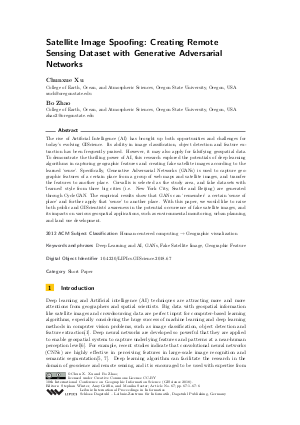Satellite Image Spoofing: Creating Remote Sensing Dataset with Generative Adversarial Networks (Short Paper)
Authors Chunxue Xu, Bo Zhao
-
Part of:
Volume:
10th International Conference on Geographic Information Science (GIScience 2018)
Part of: Series: Leibniz International Proceedings in Informatics (LIPIcs)
Part of: Conference: International Conference on Geographic Information Science (GIScience) - License:
 Creative Commons Attribution 3.0 Unported license
Creative Commons Attribution 3.0 Unported license
- Publication Date: 2018-08-02
File

PDF
LIPIcs.GISCIENCE.2018.67.pdf
- Filesize: 17.4 MB
- 6 pages
Document Identifiers
Subject Classification
ACM Subject Classification
- Human-centered computing → Geographic visualization
Keywords
- Deep Learning and AI
- GANs
- Fake Satellite Image
- Geographic Feature
Metrics
- Access Statistics
-
Total Accesses (updated on a weekly basis)
0Document
0Metadata
Abstract
The rise of Artificial Intelligence (AI) has brought up both opportunities and challenges for today's evolving GIScience. Its ability in image classification, object detection and feature extraction has been frequently praised. However, it may also apply for falsifying geospatial data. To demonstrate the thrilling power of AI, this research explored the potentials of deep learning algorithms in capturing geographic features and creating fake satellite images according to the learned 'sense'. Specifically, Generative Adversarial Networks (GANs) is used to capture geographic features of a certain place from a group of web maps and satellite images, and transfer the features to another place. Corvallis is selected as the study area, and fake datasets with 'learned' style from three big cities (i.e. New York City, Seattle and Beijing) are generated through CycleGAN. The empirical results show that GANs can 'remember' a certain 'sense of place' and further apply that 'sense' to another place. With this paper, we would like to raise both public and GIScientists' awareness in the potential occurrence of fake satellite images, and its impacts on various geospatial applications, such as environmental monitoring, urban planning, and land use development.
Cite As Get BibTex
Chunxue Xu and Bo Zhao. Satellite Image Spoofing: Creating Remote Sensing Dataset with Generative Adversarial Networks (Short Paper). In 10th International Conference on Geographic Information Science (GIScience 2018). Leibniz International Proceedings in Informatics (LIPIcs), Volume 114, pp. 67:1-67:6, Schloss Dagstuhl – Leibniz-Zentrum für Informatik (2018)
https://doi.org/10.4230/LIPIcs.GISCIENCE.2018.67
BibTex
@InProceedings{xu_et_al:LIPIcs.GISCIENCE.2018.67,
author = {Xu, Chunxue and Zhao, Bo},
title = {{Satellite Image Spoofing: Creating Remote Sensing Dataset with Generative Adversarial Networks}},
booktitle = {10th International Conference on Geographic Information Science (GIScience 2018)},
pages = {67:1--67:6},
series = {Leibniz International Proceedings in Informatics (LIPIcs)},
ISBN = {978-3-95977-083-5},
ISSN = {1868-8969},
year = {2018},
volume = {114},
editor = {Winter, Stephan and Griffin, Amy and Sester, Monika},
publisher = {Schloss Dagstuhl -- Leibniz-Zentrum f{\"u}r Informatik},
address = {Dagstuhl, Germany},
URL = {https://drops.dagstuhl.de/entities/document/10.4230/LIPIcs.GISCIENCE.2018.67},
URN = {urn:nbn:de:0030-drops-93952},
doi = {10.4230/LIPIcs.GISCIENCE.2018.67},
annote = {Keywords: Deep Learning and AI, GANs, Fake Satellite Image, Geographic Feature}
}
Author Details
References
- Jiaoyan Chen and Alexander Zipf. Deepvgi: Deep learning with volunteered geographic information. In Proceedings of the 26th International Conference on World Wide Web Companion, WWW '17 Companion, pages 771-772, Republic and Canton of Geneva, Switzerland, 2017. International World Wide Web Conferences Steering Committee. URL: http://dx.doi.org/10.1145/3041021.3054250.
-
Ian J Goodfellow, Jean Pouget-Abadie, Mehdi Mirza, Bing Xu, David Warde-Farley, Sherjil Ozair, Aaron Courville, and Yoshua Bengio. Generative adversarial networks. Advances in Neural Information Processing Systems, 3:2672-2680, 2014.

- Zhi He, Han Liu, Yiwen Wang, and Jie Hu. Generative adversarial networks-based semi-supervised learning for hyperspectral image classification. Remote Sensing, 9(10):1042, 2017. URL: http://dx.doi.org/10.3390/rs9101042.
- Phillip Isola, Jun-Yan Zhu, Tinghui Zhou, and Alexei A. Efros. Image-to-image translation with conditional adversarial networks. CoRR, abs/1611.07004, 2016. URL: http://arxiv.org/abs/1611.07004.
- Alex Krizhevsky, Ilya Sutskever, and Geoffrey E. Hinton. Imagenet classification with deep convolutional neural networks. In Proceedings of the 25th International Conference on Neural Information Processing Systems - Volume 1, NIPS'12, pages 1097-1105, USA, 2012. Curran Associates Inc. URL: http://dl.acm.org/citation.cfm?id=2999134.2999257.
-
Huina Mao, Yingjie Hu, Bandana Kar, Song Gao, and Grant McKenzie. Geoai 2017 workshop report. The 1st ACM SIGSPATIAL International Workshop on GeoAI: @AI and Deep Learning for Geographic Knowledge Discovery: Redondo Beach, CA, USA - November 7, 2016, 9:25-25, 01 2018.

- Karen Simonyan and Andrew Zisserman. Very deep convolutional networks for large-scale image recognition. CoRR, abs/1409.1556, 2014. URL: http://arxiv.org/abs/1409.1556.
- Liangpei Zhang, Lefei Zhang, and Bo Du. Deep learning for remote sensing data: A technical tutorial on the state of the art. IEEE Geoscience and Remote Sensing Magazine, 4(2):22-40, June 2016. URL: http://dx.doi.org/10.1109/MGRS.2016.2540798.
- Bo Zhao and Daniel Z. Sui. True lies in geospatial big data: detecting location spoofing in social media. Annals of GIS, 23(1):1-14, 2017. URL: http://dx.doi.org/10.1080/19475683.2017.1280536.
- Jun-Yan Zhu, Taesung Park, Phillip Isola, and Alexei A Efros. Unpaired image-to-image translation using cycle-consistent adversarial networks. In 2017 IEEE International Conference on Computer Vision (ICCV), volume 00, pages 2242-2251, Oct. 2018. URL: http://dx.doi.org/10.1109/ICCV.2017.244.
